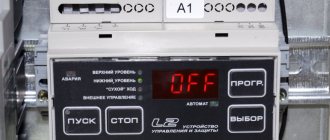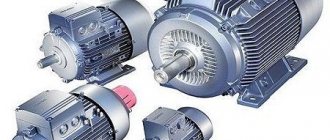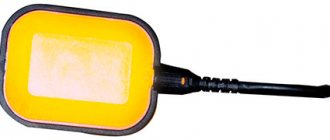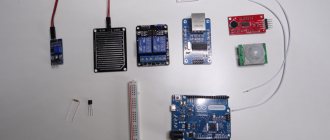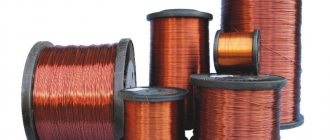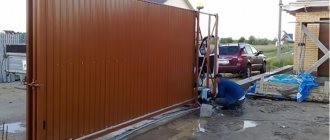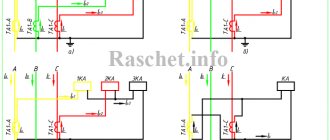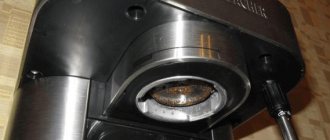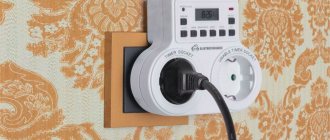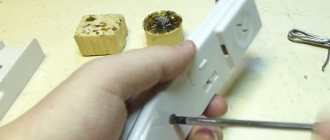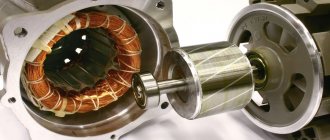If you need to supply water in an area that is far from the water supply system, most often a well is drilled. For normal water supply and pressure creation, you need automation for the well pump to the motor. Let's consider its varieties, in what cases it should be installed and how to connect it to the pump. Let's look at the rules for use, maintenance, and selection of elements for such a block.
Surface pump with automation unit Source unipump.ru
What is automation for a pump and why is it needed?
In areas where it is not possible to connect to the general water supply system, a well is often drilled, which becomes a source of water. But to create a complete plumbing system you need a pump. With its help, water will be pumped into the pipes, and in order not to start it manually, automation for the well is used. This is a device for automatically starting a pump or monitoring the presence of water.
If there is automation, the pump can independently pump liquid into the system or supply it to the upper floors. Also, if you have automation and a heating boiler, you can make a heating system that will pump water to create pressure and drive it through pipes not only into radiators, but also into a shower or sink. Using automation, you can prevent overheating of the motor and avoid idle operation of the dispenser (when there is no water in it).
Example of a control unit with a tank Source inhouse-spb.ru
Installation of a submersible pump and its connection
To install a submersible pump, they usually use a head placed in a caisson pit along with the equipment or an adapter cut into the side wall of the casing. In the latter case, all automatic units are located in a residential building or a separate outbuilding.
Fig. 13 Diagram of connection and installation of deep-well pumps in a well
Automation for a well should be selected according to the main criteria, which include the cost associated with the submersible electric pump used. When using inexpensive electric pumps of domestic or Chinese production, it is enough to use the simplest automatic devices - the functions of expensive control units with such units will not be fully realized. If you purchase an expensive device (for example, a Grundfos electric pump for $1000) with frequency control of the electric motor rotation speed, using any other devices other than the native Grundfos PM2 module does not make any sense.
Types of automation
Automation for well pumps has existed for quite a long time and now you can purchase devices of three different generations. They differ in the complexity of the mechanism, the functions they can perform, and also in cost.
First generation
The first generation includes the simplest devices that perform specific functions. With their help, it is impossible to create an autonomous water supply system, since most often these devices are mechanical.
Example of simple first generation automation Source www.italflexo.cz
The pressure switch is one of the most necessary and useful mechanisms in the water supply system. Inside such a device there is a capsule with a spring that closes the contact if the pressure drops. After the water supply stops, the motor pumps up the liquid and opens the terminals. This device must be used in combination with a storage tank. There must be a pressure sensor (pressure gauge) on the body of the relay or near its connection.
Example of a spring pressure control relay Source 4-stihii.ru
A hydraulic accumulator is a storage tank into which water is collected. It helps to avoid frequent activation of the pump and mitigate water hammer, for example, when closing a tap. There is a membrane installed in the tank that squeezes out the water. For it to work, the pressure in the system must be increased so that it is higher than in the membrane.
When the tap is open, water is squeezed out of the tank and the membrane is filled with air. If the pressure drops to the value set on the relay, the power circuit will close and the container will be refilled with liquid. The hydraulic accumulator is most often made of ferrous metal or stainless steel, and a pressure gauge is installed on their body, which shows the pressure inside the tank and helps adjust the water supply.
Storage tanks with different sizes Source maxidom.by
Automation for a pump with a hydraulic accumulator and a pressure switch needs to be supplemented with a float and a relay that prevents idle operation. The first device is needed to control the presence of water. If it falls below the minimum mark, the float will turn off the power to the pump so that it does not overheat. It can be mounted separately on the pump wall or built into the system. Floats are most often installed inside the automation for a submersible pump.
To adjust the water level, you can install an electrolytic sensor instead of a float. It is suitable for placement inside wells and consists of 2 conductors that close the power circuit only if they are in water.
Press control is also used for similar purposes. It consists of a magnetic curtain that is lowered into the water and a reed switch (sealed contact). If there is water in the system, the curtain rises and closes the circuit using a magnetic field, and if there is no liquid, it lowers and interrupts the current supply.
Fluid flow switch (press control) Source ebayimg.com
The level of protection activation depends on the size of the petal, and for finer adjustments there are models in which you can change the distance between the reed switch and the shutter. Flow switches are rarely used for outdoor pumps. Due to the nature of the mechanism, it does not need idle protection.
The idle speed lock is needed to prevent the pump from burning out. It is installed complete with other elements, for example, a tank and a water pressure regulator. The principle of operation of the blocker is similar to the pressure regulator, only it opens the circuit if there is not enough water in the system. The power off limit can be set using the adjustment screws. Most often, such blockers are installed on pumps that stand on the surface.
Power cut-off unit during idle operation Source geyser.com.ua
Second generation
This type of automation unit for a well pump usually consists of electrical devices with sensors that supply data to a microcircuit, which ensures autonomous water supply. Electronic devices are mounted on a pumping station without a hydraulic accumulator, since the sensors operate constantly, but to compensate for water hammer it is recommended to install a tank of at least 5 liters.
Temperature sensors must be installed inside such a unit to ensure that the motor or other components do not overheat, as well as an emergency engine shutdown unit when jammed. In the second generation, all elements are most often located in one case and have a graphical interface for displaying data.
Idle speed blockers and press control are installed inside such blocks. The advantage of such systems is that they take up little space if you do not install a storage tank. Elements in the design can be mechanical (to save money) or electronically controlled (more expensive).
Pressure switch
The main working elements are two springs and a flexible membrane. Water puts pressure on the membrane. When the tap is opened, the pressure in the pipes drops, the spring expands and closes the circuit. The well pump turns on. When the tap is closed, the water pressure increases, the spring compresses and the circuit opens. The pump turns off automatically.
The large screw is responsible for the lower P value, the small screw for the upper one. When setting, rotate both screws to set acceptable values. Standardly, the relay operates in the range of 1.5-3 atm.
Video description
This video shows an analysis of the types of automation and its components:
See also: Companies specializing in equipment for water supply, heating, sewerage and septic tank systems.
Elements of the second generation system often fail because it operates at maximum performance during startup. In order to avoid breakdowns, careful adjustment of all parts or a frequency converter, which is installed in more expensive systems, is required. Automation for a pump without a hydraulic accumulator will fail faster than with an additional tank. Electronic units have a higher cost than mechanical ones.
For modular automatic control units, the performance directly depends on the network voltage, since if there is a lack of power, the motor will not operate at full power or will not start at all. Also, most well pump control units contain fixed settings that are suitable only for a certain engine model.
Automatic control module for pump Source cdek.market
Third generation
Third generation automation are devices that have the highest reliability, power and cost. It differs from its predecessor by the presence of speed control.
The most important part of this automation unit for a well pump with a hydraulic accumulator and a pressure switch is the frequency converter. It helps reduce engine load, extend operating time and reduce electricity use.
When the pump is running, this module independently reduces its power. For example, if you open only one tap, the system will not start at its limit, but after opening the second tap, the pressure will drop and the converter will increase the pressure.
Due to its high cost, a frequency converter is not often mounted in a control unit. It is recommended to install a small hydraulic accumulator with the automation for the well pump, which will prevent the frequency converter from restarting if there is a water leak.
K561LA7 microcircuit and do-it-yourself pumping station automation for a private home
Owners of individual buildings erect wells or artesian wells near their homes, which provide them with water.
A few decades ago it was carried in buckets. However, we live in a time when automation has become accessible to the common man.
It can significantly facilitate heavy physical labor and free up time for productive intellectual activity.
The published article contains advice for a home craftsman on how to make a simple automatic water pump control based on the available K561LA7 microcircuit. It copes well with the water supply of a private home. It is easy to make it yourself. The presented material is supplemented by explanatory pictures, diagrams and a video.
Video description
This video shows an analysis of individual parts of the automation and their properties:
In the third generation system, surge protection devices are installed in the network, which prevent the combustion of electronic elements inside the control unit, as well as its restart after a surge.
Also, for such systems, a control cabinet is installed, which is similar to an electrical distribution panel. For submersible pumps, it is more important than for external ones, since it can be used to adjust the operation of the device, but getting to the submersible pump is problematic.
Inside such a cabinet there are fuses and all control elements, for example, a smooth motor start and a frequency converter regulator. Also inside are current sensors and a motor shaft speed controller. It is recommended to install third-level systems with a control cabinet if you need to connect several wells to each other.
Submersible pump control system (electrical cabinet) Source www.owen.ru
Reed switch device
The main actuator element of the reed switch is the reed switch. The device is a small glass cylinder filled with an inert gas or with air evacuated. Gas or vacuum prevents the formation of sparks and oxidation of the contact group. Inside the flask there are closed contacts made of a ferromagnetic alloy of rectangular cross-section (permalloy wire) coated with gold or silver. When exposed to a magnetic flux, the contacts of the reed switch are magnetized and repel each other - the circuit through which the electric current flows opens.
Rice. 4 Appearance of reed switches
The most common types of reed switches operate on a closure, that is, when magnetized, their contacts are connected to each other and the electrical circuit is closed. Reed switches may have two terminals for making or breaking a circuit, or three if used to switch electrical current circuits. The low voltage circuit that switches the power supply to the pump is usually located in the control cabinet.
Types of pumps
Before choosing automation for a well with a submersible pump, you need to consider how the pump works in order to understand how to increase its efficiency and reduce costs. Submersible pumps are either centrifugal or vibration pumps. Both of these options need to be placed in water in order for them to work. That's why they are called submersible.
Pumps of this type can pump water from a depth that does not exceed 10 m. If it is greater, then you will have to use specialized deep devices. Vibration pumps operate by deforming the membrane. During oscillations, the pressure in the system equalizes, which leads to pumping of water.
A centrifugal pump works by rotating blades inside a housing, which create pressure and pump water. This model is the most common due to its availability and cost, and it is also easier to install than a vibration model.
An example of a centrifugal pump with automation Source unipump.ru
Automation for a submersible pump with a hydraulic accumulator and a pressure switch most often has a remote control for controlling pressure and speed, a flow meter and a maintenance unit. It is also equipped with protection against air ingress. If he sees that there is no water on the sensor, then the engine will not start. Most often, all controls are displayed on a separate panel, which is located outside the well. This way you don’t have to pull out the pump for adjustment, as this can damage it, and you can also adjust the engine speed and pressure limits for automatic operation.
External pumps are rarely used for pumping water from great depths, and their automation does not require many additional modules. Its automation most often consists of a storage tank, a pressure control unit and a water sensor. Expensive models are complemented by temperature sensors and a speed control module.
Automation unit for water supply Source wixstatic.com
Installation of automation
To install automation on a pump, you need to know how to connect the components correctly. The diagram may differ for different blocks, and its features are most often found in the accompanying documentation for the block. As an example, we can consider the installation of the first generation system, since it is the simplest.
First, you should put an “American” (special fitting) on the thread of the hydraulic accumulator, so that you can then connect a tee to it. It is also useful for conveniently replacing components, since the fitting is easily removed. A sensor for adjusting and measuring pressure must be installed in the thread of the tee.
All connections should be sealed with fum tape to prevent leakage and pressure loss. Next, one end of the pipe needs to be secured to the hydraulic accumulator, and the other to the pump.
The pipe with the pump should be laid on a flat surface. You need to thread a 3 m long fall insurance cable into the loops on the device body, then attach it and the power cable to the pipe at intervals of 150 cm. The second part of the cable needs to be hooked next to the well.
Example of installation of a submersible pump Source dovidkam.com
Video description
This video shows how to properly install the automation:
The length of the pipe should be sufficient to immerse it in water at least 1 m so that air cannot enter the system, as this may cause the motor to burn out. Before starting the system, you should fill it with water to squeeze out the air. If the automation for the pump with a hydraulic accumulator has been installed correctly, then after activating the power, the water supply will begin.
Submersible pump with automation and hydraulic accumulator Source unipump.ru
Principle of operation and varieties
The operating principle of automation for a downhole electric pump is based on changing the physical parameters of water in the line and water intake source. An automatic well pump turns off and on when pressure changes, the height of the water column in the source, the speed of liquid movement through the pipeline or its loss in the line.
When using submersible electric pumps, separate control units and a hydraulic accumulator are installed in the pipeline; in more modern modular models, all devices are combined in one unit.
When using surface units, all control elements are mounted on one frame; the module is called a pumping station - using it is much more convenient than installing all the elements in a line yourself.
Tips for selection and application
Before choosing a pressure regulator, you should understand how high the water supply is required, since the standard pressure is from 1.5 to 3 atm, and to supply water for every 5 m you need to add another 0.5 atm to this figure. Therefore, for the 2nd floor the minimum pressure will be from 2 to 3.5 atm.
You should also install a block on the pump that prevents damage from voltage surges. It also acts as a stabilizer for the current power supplied to the system. At critical values, the protection will turn off the power, and if the indicators are slightly different, but are not limiting, then it equalizes the voltage.
Before you start using the automation and pump, it is recommended to carefully configure all parameters, since they may be different for each well. Also, the settings depend on the presence of a hydraulic accumulator and its volume.
Float water level gauges
An economically feasible solution for level monitoring up to 1.5...2 meters with an accuracy of ±5 mm. Highly accurate water level measurement solution for custody transfer metering. Visual sensor combined with an electronic level gauge for boilers and pressure tanks.| Modification | Photo | Switching function | Switching voltage | Switching current | Output element | Material | Ambient temperature | ||
| DC | A.C. | DC | A.C. | ||||||
| PDU-T101 | 220 V | 240 V | 0.7 A | 0.5 A | Reed switch | Stainless steel steel | -20…+125 °C | ||
| PDU-T102 | 220 V | 240 V | 0.7 A | 0.5 A | Reed switch | Stainless steel steel | -20…+125 °C | ||
| PDU-T104 | 220 V | 240 V | 0.7 A | 0.5 A | Reed switch | Stainless steel steel + polypropylene | -10…+80 °C | ||
| PDU-T106 | 220 V | 240 V | 0.7 A | 0.5 A | Reed switch | Polypropylene | -10…+80 °C | ||
| PDU-T121-065-115 | 220 V | 240 V | 0.7 A | 0.5 A | Reed switch | Stainless steel steel | -20…+125 °C | ||
| PDU-T301 | 220 V | 240 V | 0.7 A | 0.5 A | Reed switch | Stainless steel steel | -20…+125 °C | ||
| PDU-T302 | 220 V | 240 V | 0.7 A | 0.5 A | Reed switch | Stainless steel steel | -20…+125 °C | ||
| PDU-T321-060-110 | 220 V | 240 V | 0.7 A | 0.5 A | Reed switch | Stainless steel steel | -20…+125 °C | ||
| PDU-T501 | 220 V | 240 V | 0.7 A | 0.5 A | Reed switch | Polypropylene | -10…+80 °C | ||
| PDU-T502 | 220 V | 240 V | 0.7 A | 0.5 A | Reed switch | Polypropylene | -10…+80 °C | ||
| PDU-T505 | 220 V | 240 V | 0.7 A | 0.5 A | Reed switch | Stainless steel steel | -20…+125 °C | ||
| PDU-T601-2 | 220 V | 220 V | 10 A | 10 A | Relay | Polypropylene | -10…+80 °C | ||
| PDU-T601-5 | 220 V | 220 V | 10 A | 10 A | Relay | Polypropylene | -10…+80 °C | ||
Video description
This video shows how to properly configure a pressure switch:
Automation should be installed only if it is necessary. For example, for an autonomous heating system. To water the site in the summer seasons, automation is not needed. A simple pump will suffice for this. A pump that has a performance higher than the well's flow rate (return) will supply water in jerks, which can lead to breakdown.
The automation control unit should be placed in a dry place so that the contacts inside the system do not oxidize and a short circuit occurs. Also, the place should be easily accessible, since in the event of a breakdown or when changing settings, it will be inconvenient to approach the unit if it is blocked.
AQUAROBOT control units are modern and reliable electronic devices that allow you to organize the operation of a surface or well pump in automatic mode.
Using built-in flow and pressure sensors (depending on the model), the unit analyzes the current state of the system, providing comfortable water use and protecting the pump from “dry running”.
Based on AQUAROBOT blocks, AQUAROBOT automation kits with a hydraulic accumulator are produced, which are ready-made solutions for controlling single-phase pumps and simplify system installation.
Periodic maintenance of the automation unit (adjustment, performance testing, replacement of parts) should be carried out. This is required because if the motor does not operate correctly and is not turned on in a timely manner, the contacts in the pump burn out and it stops working.
Automation unit service Source mhs-perm.ru
Installation of electronic automation should only be carried out if you have experience. If it is not there, then it is better to contact specialists, since an incorrectly installed system will quickly fail or not start working at all.
If an external pump is used, which is connected to a well, then a storage tank (if there is none) and a pressure regulator should be installed for it. There are external pumps that come complete with these modules or are initially connected to its housing. You should also install a fluid flow relay in the form of electrolytic sensors. This will prevent air from entering the motor.
Expensive systems are best installed if frequent use of water in different volumes is required, since they will be able to regulate its flow.
Well automation control unit Source aspekt-ekb.ru
